Optimal Current Allocation Strategy for Hybrid Hierarchical HVDC System with Parallel Operation of High-Voltage and Low-Voltage DC Lines
Abstract
:1. Introduction
2. Model of Hybrid Hierarchical HVDC System
2.1. Selection of System Topology
2.2. LCC and VSC Station
2.3. System Equivalent Circuit
3. HVDC Transmission Loss Model Based on Multi-Order Fitting Method
3.1. Loss Model of LCC Station
3.2. Loss Model of MMC Station
3.3. Loss Model of Transmission Line
3.4. Loss Model of Hybrid Hierarchical HVDC
4. Current Allocation Strategy considering Multi-Objective Optimization Method
4.1. Multi-Objective Optimization Model
4.2. Optimal Current Allocation Strategy Based on Multi-Objective Genetic Algorithm
5. Case Study
5.1. Results of Optimal Current Allocation Strategy
5.2. Steady Characteristics
5.3. Step Characteristics
5.4. AC Fault at Rectifier Side
5.5. AC Fault at Inverter Side
6. Conclusions
Author Contributions
Funding
Institutional Review Board Statement
Informed Consent Statement
Data Availability Statement
Conflicts of Interest
Nomenclature
| General and Abbreviation | |
| HVDC | High-voltage direct current. |
| HVAC | High-voltage alternative current. |
| LCC | Line commutated converter. |
| VSC | Voltage source converter. |
| DC | Direct current. |
| kV | Kilovolt. |
| GW | Gigawatt. |
| MW | Megawatt. |
| MMC | Modular multilevel converter. |
| SM | Sub-module. |
| E | Effective value of line voltage. |
| U | DC voltage. |
| I | DC current. |
| P | Active power. |
| Q | Reactive power. |
| X | Commutation reactance. |
| α | Trigger delay angle of LCC. |
| β | Trigger advance angle of LCC. |
| L | Equivalent inductance. |
| R | Equivalent resistance. |
| PSCAD | Power systems computer-aided design. |
| Subscripts | |
| a, b, c | Quantities of a, b and c-phase. |
| r, i | Quantities of rectifier and inverter side. |
| max, min | Quantities of maximum and minimum. |
| Ref_Up | Quantity of high-voltage converter. |
| Ref_Lo | Quantity of low-voltage converter. |
References
- Wang, M.; An, T.; Ergun, H.; Lan, Y.; Andersen, B.; Szechtman, M.; Leterme, W.; Beerten, J.; Hertem, D.V. Review and Outlook of HVDC Grids as Backbone of Transmission System. CSEE J. Power Energy Syst. 2021, 7, 797–810. [Google Scholar]
- Luo, X.; Li, F.; Fan, L.; Niu, T.; Li, B.; Tian, L.; Yu, H. Influence of Synchronous Condensers on Operation Characteristics of Double-Infeed LCC-HVDCs. Processes 2021, 9, 1704. [Google Scholar] [CrossRef]
- Ayobe, A.S.; Gupta, S. Comparative Investigation on HVDC and HVAC for Bulk Power Delivery. Mater. Today Proc. 2022, 19, 958–964. [Google Scholar] [CrossRef]
- The International Renewable Energy Agency (IRENA). Renewable Capacity Statistics 2021. Available online: https://www.irena.org/publications/2021/March/Renewable-Capacity-Statistics-2021 (accessed on 1 March 2021).
- Wang, J.; Huang, M.; Fu, C.; Li, H.; Xu, S.; Li, X. A New Recovery Strategy of HVDC System during AC Faults. IEEE Trans. Power Del. 2019, 34, 486–495. [Google Scholar] [CrossRef]
- Liang, X.; Mehdi, A. HVDC Transmission and Its Potential Application in Remote Communities: Current Practice and Future Trend. IEEE Trans. Ind. Appl. 2022, 58, 1706–1719. [Google Scholar] [CrossRef]
- Sang, Y.; Yang, B.; Shu, H.; An, N.; Yu, T. Fault Ride-Through Capability Enhancement of Type-4 WECS in Offshore Wind Farm via Nonlinear Adaptive Control of VSC-HVDC. Processes 2019, 7, 540–561. [Google Scholar] [CrossRef] [Green Version]
- Zhao, Z.; Iravani, M.R. Application of GTO Voltage Source Inverter in a Hybrid HVDC Link. IEEE Trans. Power Del. 1994, 9, 369–377. [Google Scholar] [CrossRef]
- Chang, Y.; Cai, X. Hybrid Topology of a Diode-Rectifier-Based HVDC System for Offshore Wind Farms. IEEE Trans. Emerg. Sel. Topics Power Electron. 2019, 7, 2116–2128. [Google Scholar] [CrossRef]
- Bakas, P.; Okazaki, Y.; Shukla, A.; Patro, S.K.; Nami, A. Review of Hybrid Multilevel Converter Topologies Utilizing Thyristors for HVDC Applications. IEEE Trans. Power Electron. 2021, 36, 174–190. [Google Scholar] [CrossRef]
- Xiao, H.; Sun, K.; Pan, J.; Li, Y.; Liu, Y. Review of Hybrid HVDC Systems Combining Line Communicated Converter and Voltage Source Converter. Int. J. Electr. Power Energy Syst. 2021, 129, 1–9. [Google Scholar] [CrossRef]
- Li, Z.; He, Y.; Li, Y.; Gu, W.; Tang, Y.; Zhang, X.P. Hybrid Control Strategy for AC Voltage Stabilization in Bipolar VSC-MTDC. IEEE Trans. Power Syst. 2019, 34, 129–139. [Google Scholar] [CrossRef]
- Lee, G.; Hwang, P.I.; Moon, S.I. Reactive Power Control of Hybrid Multi-Terminal HVDC Systems Considering the Interaction Between the AC Network and Multiple LCCs. IEEE Trans. Power Syst. 2021, 36, 4562–4574. [Google Scholar] [CrossRef]
- Chen, X.; Li, H.; Wang, G.; Xu, C.; Liang, Y. A Convolution Power-Based Protection Scheme for Hybrid Multiterminal HVDC Transmission Systems. IEEE Trans. Emerg. Sel. Topics Power Electron. 2021, 9, 1655–1667. [Google Scholar] [CrossRef]
- Ni, X.; Gole, A.M.; Zhao, C.; Guo, C. An Improved Measure of AC System Strength for Performance Analysis of Multi-Infeed HVdc Systems Including VSC and LCC Converters. IEEE Trans. Power Del. 2018, 33, 169–178. [Google Scholar] [CrossRef]
- Zhu, J.; Li, S.; Yu, L.; Bu, S.; Li, Y.; Deng, Z.; Wang, Y.; Jia, H.; Wang, C.; Liu, D. Coherence Analysis of System Characteristics and Control Parameters for Hybrid HVDC Transmission Systems Based on Small-Signal Modeling. IEEE Trans. Emerg. Sel. Topics Power Electron. 2021, 9, 7436–7446. [Google Scholar] [CrossRef]
- He, Y.; Xiang, W.; Ni, B.; Lu, X.; Wen, J. Impact of Strength and Proximity of Receiving AC Systems on Cascaded LCC-MMC Hybrid HVDC System. IEEE Trans. Power Del. 2021, 1. [Google Scholar] [CrossRef]
- Sreedevi, J.; Manohar, P.; Aradhya, R. Dynamic Performance of Hybrid Multiinfeed HVDC System on RTDS. In Proceedings of the Eighteenth National Power Systems Conference (NPSC), Guwahati, India, 18–20 December 2014. [Google Scholar]
- Guo, C.; Wang, Y.; Li, J.; Zhao, C.; Fu, C. Design and Development of Experimental Platform for Hybrid HVDC System. High Volt. Eng. 2019, 45, 3157–3163. [Google Scholar]
- Xiao, H.; Duan, X.; Zhang, Y.; Li, Y. Analytically Assessing the Effect of Strength on Temporary Overvoltage in Hybrid Multi-Infeed HVDC Systems. IEEE Trans. Power Electron. 2022, 37, 2480–2484. [Google Scholar] [CrossRef]
- Cheng, F.; Yao, L.; Xu, J.; Chi, Y.; Sun, Y.; Wang, Z.; Li, Y. A new AC Fault Ride-through Strategy for HVDC Link with Serial Connected LCC-VSC Hybrid Inverter. CSEE J. Power Energy Syst. 2022, 8, 175–187. [Google Scholar]
- Liu, Y.; Luo, G.; Yang, Y.; Zhang, X.; Yang, L. Adaptability Analysis of Traveling Wave Protection in Multi-terminal Hybrid DC Transmission Lines. In Proceedings of the 2020 4th International Conference on HVDC (HVDC), Xi’an, China, 6–9 November 2020. [Google Scholar]
- Hou, J.; Song, G.; Chang, P.; Xu, R.; Hussain, K. Fault Identification Scheme for Hybrid Multi-terminal HVDC System Based on Control and Protection Coordination Strategy. Int. J. Electr. Power Energy Syst. 2022, 136, 1–13. [Google Scholar] [CrossRef]
- Guo, C.; Wu, Z.; Yang, S.; Hu, J. Overcurrent Suppression Control for Hybrid LCC/VSC Cascaded HVDC System Based on Fuzzy Clustering and Identification Approach. IEEE Trans. Power Del. 2021, 1. [Google Scholar] [CrossRef]
- Qin, Y.; Wen, M.; Yin, X.; Bai, Y.; Fang, Z. Comprehensive Review of Commutation Failure in HVDC Transmission Systems. Electr. Power Syst. Res. 2022, 205, 1–10. [Google Scholar]
- Farina, M.; Amato, P. A Fuzzy Definition of “Optimality” for Many-criteria Optimization Problem. IEEE Trans. Syst. Man Cybern. A Syst. Hum. 2004, 34, 315–326. [Google Scholar] [CrossRef]
- Ouyang, J.; Zhang, Z.; Li, M.; Pang, M.; Diao, Y. A Predictive Method of LCC-HVDC Continuous Commutation Failure Based on Threshold Commutation Voltage under Grid Fault. IEEE Trans. Power Syst. 2021, 36, 118–126. [Google Scholar] [CrossRef]

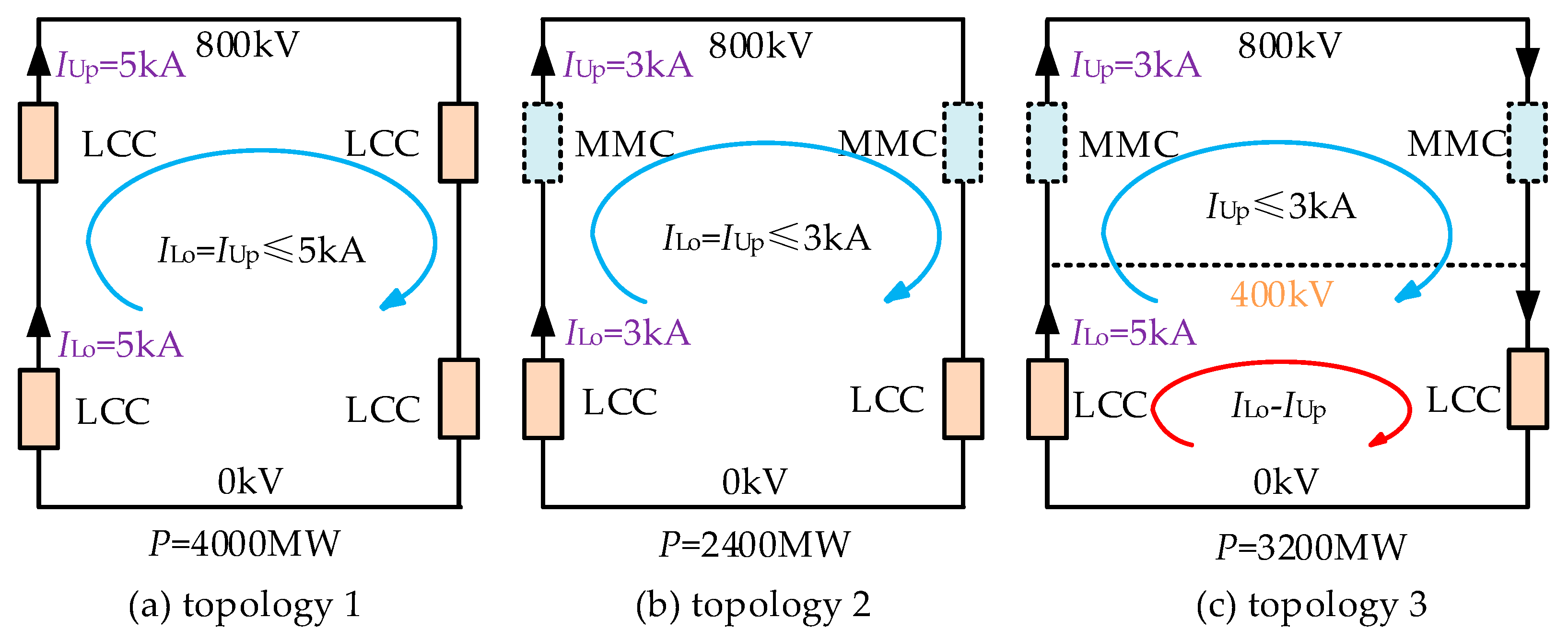
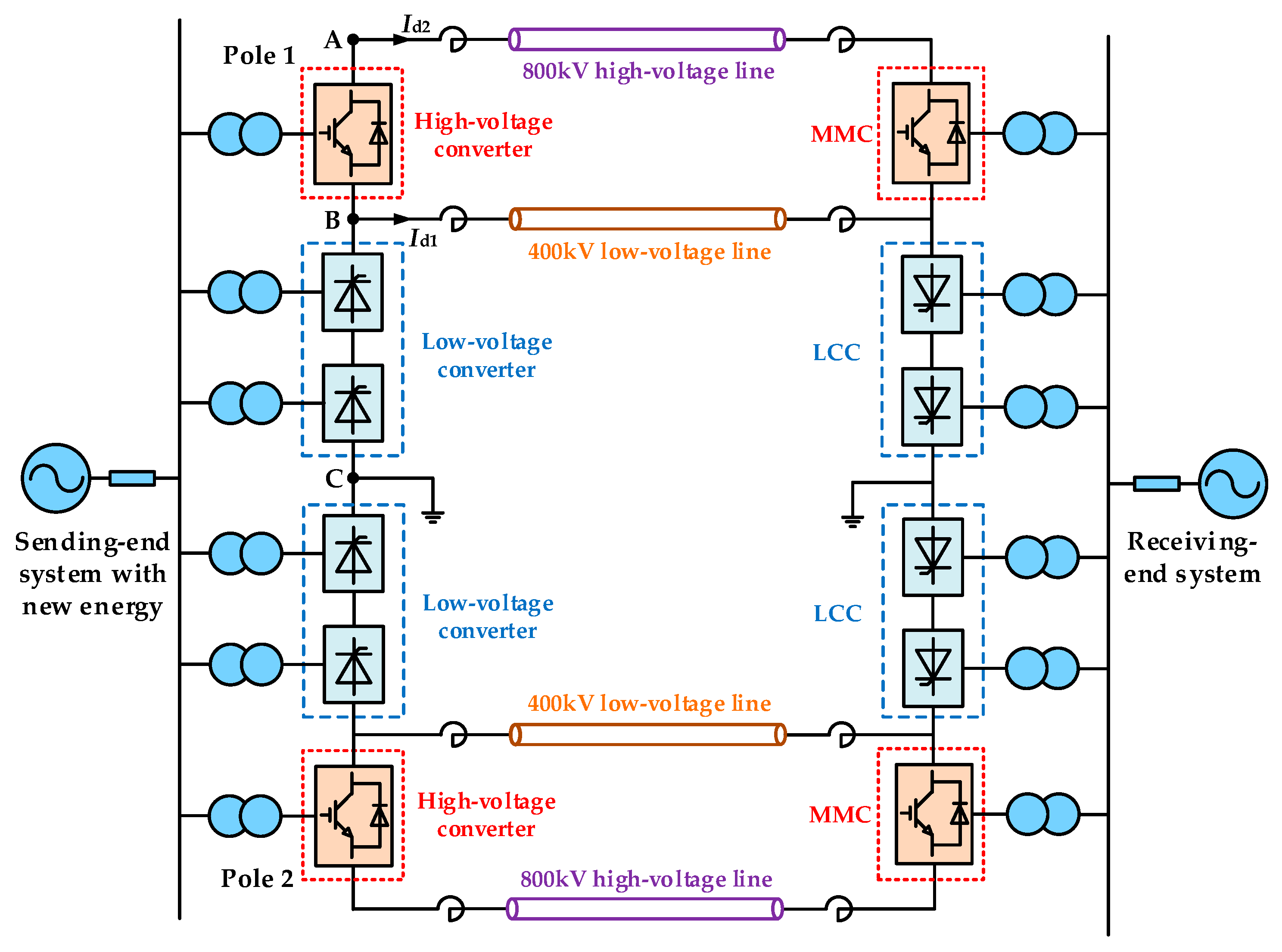
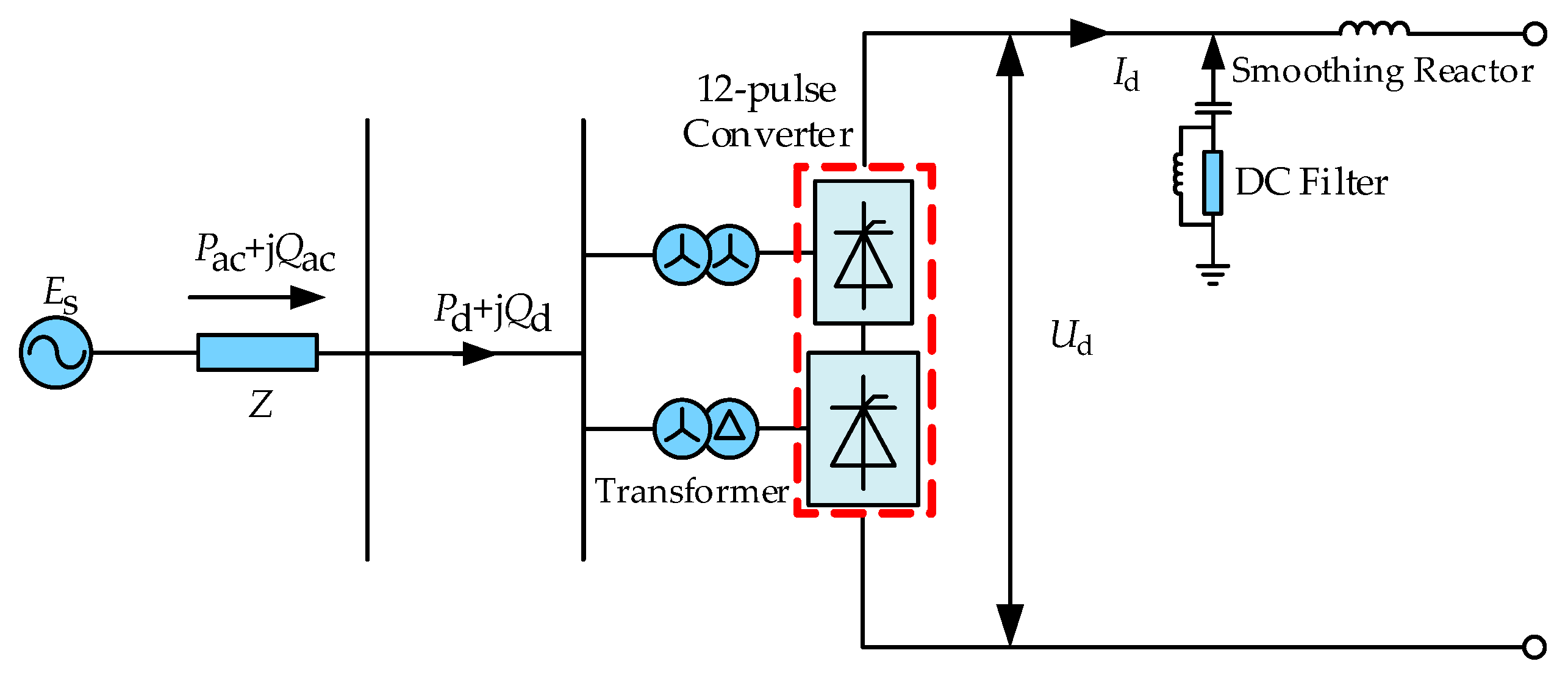

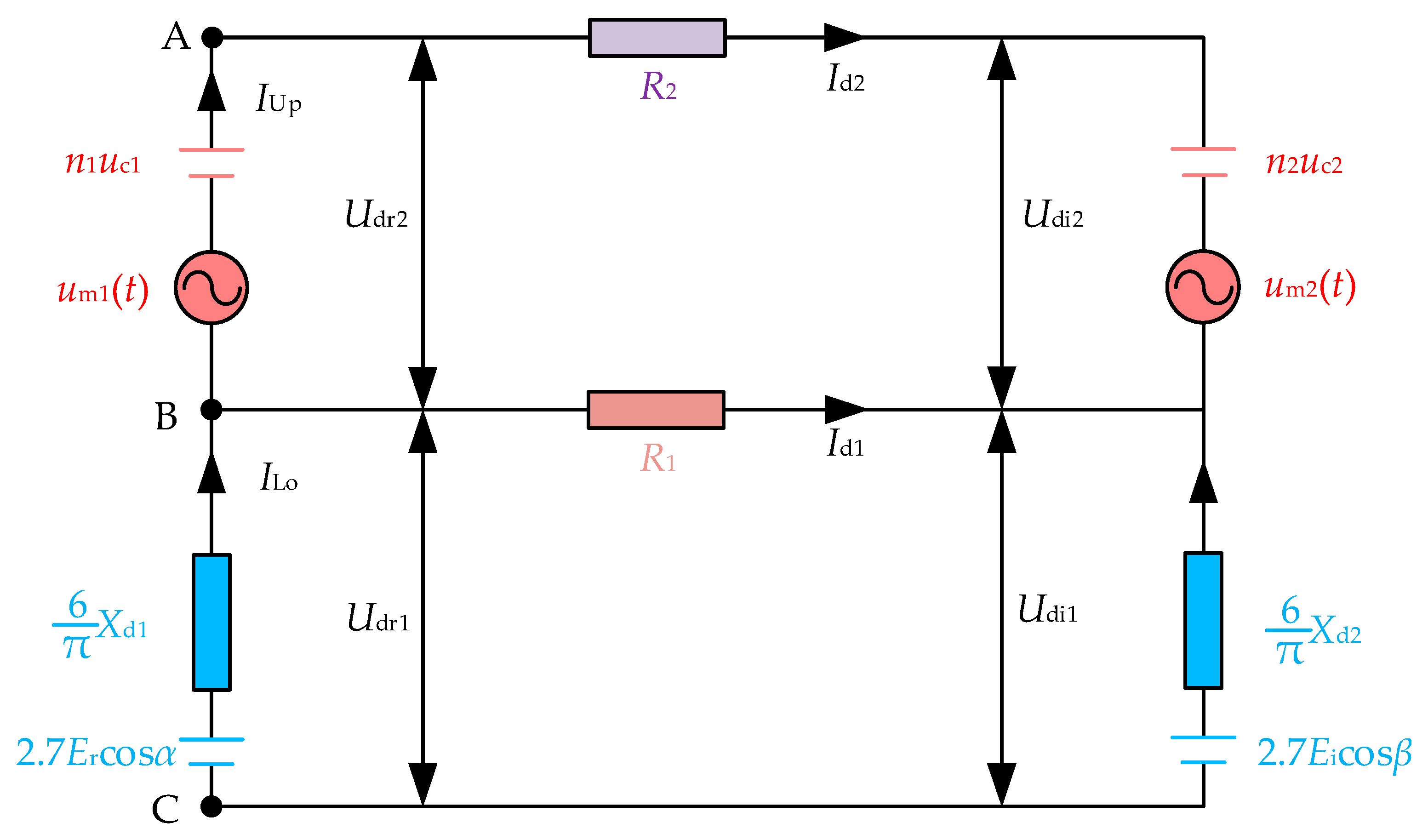
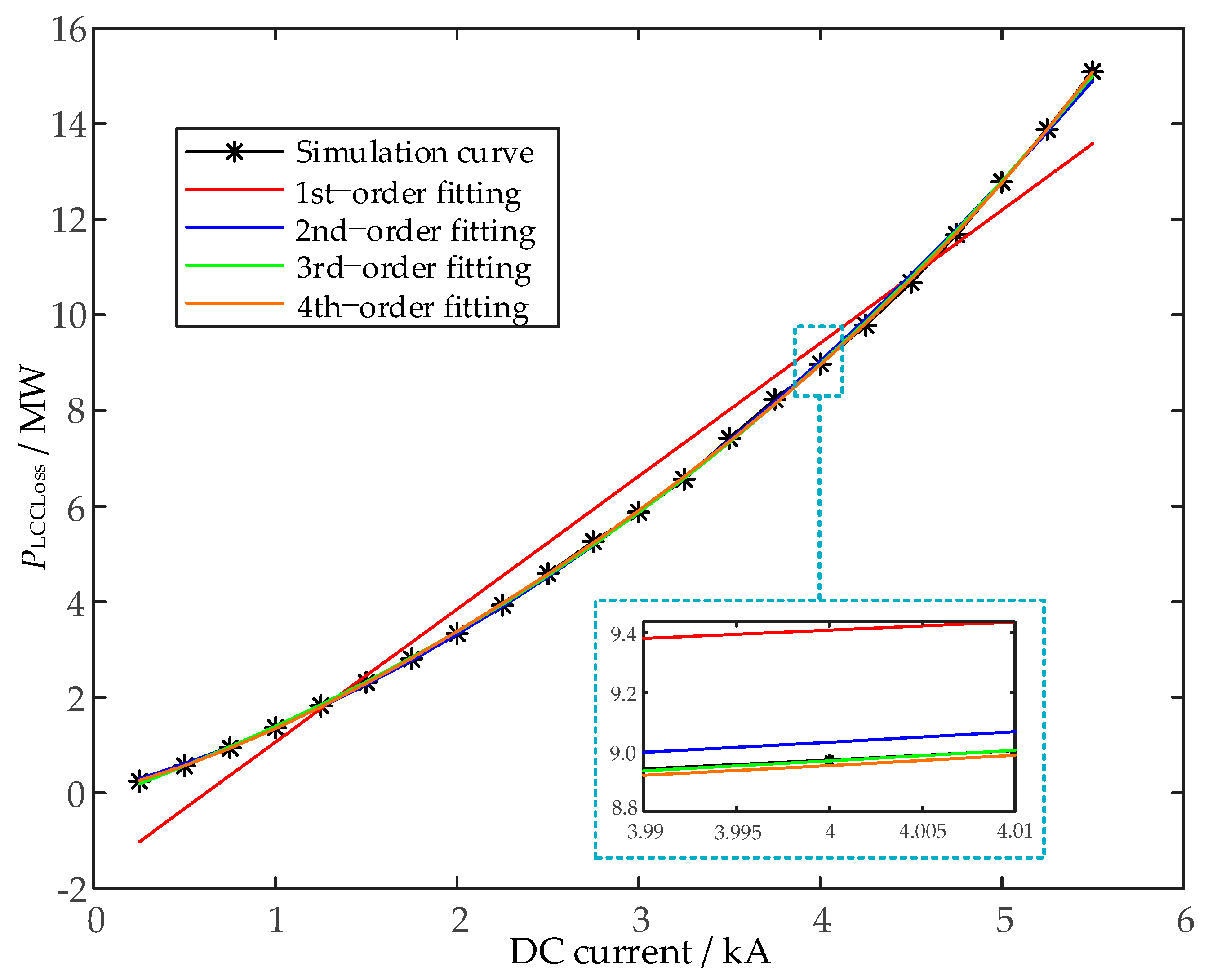
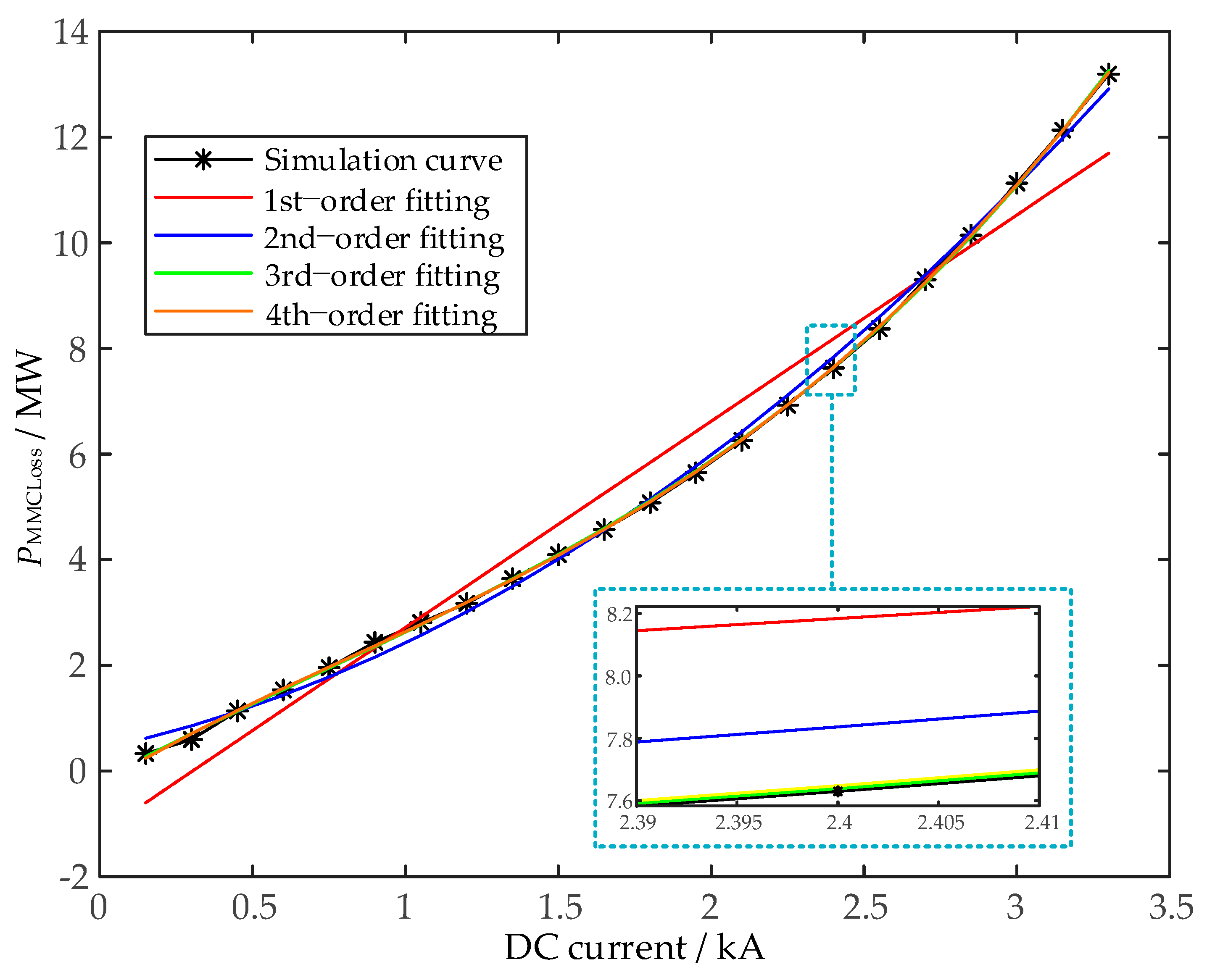


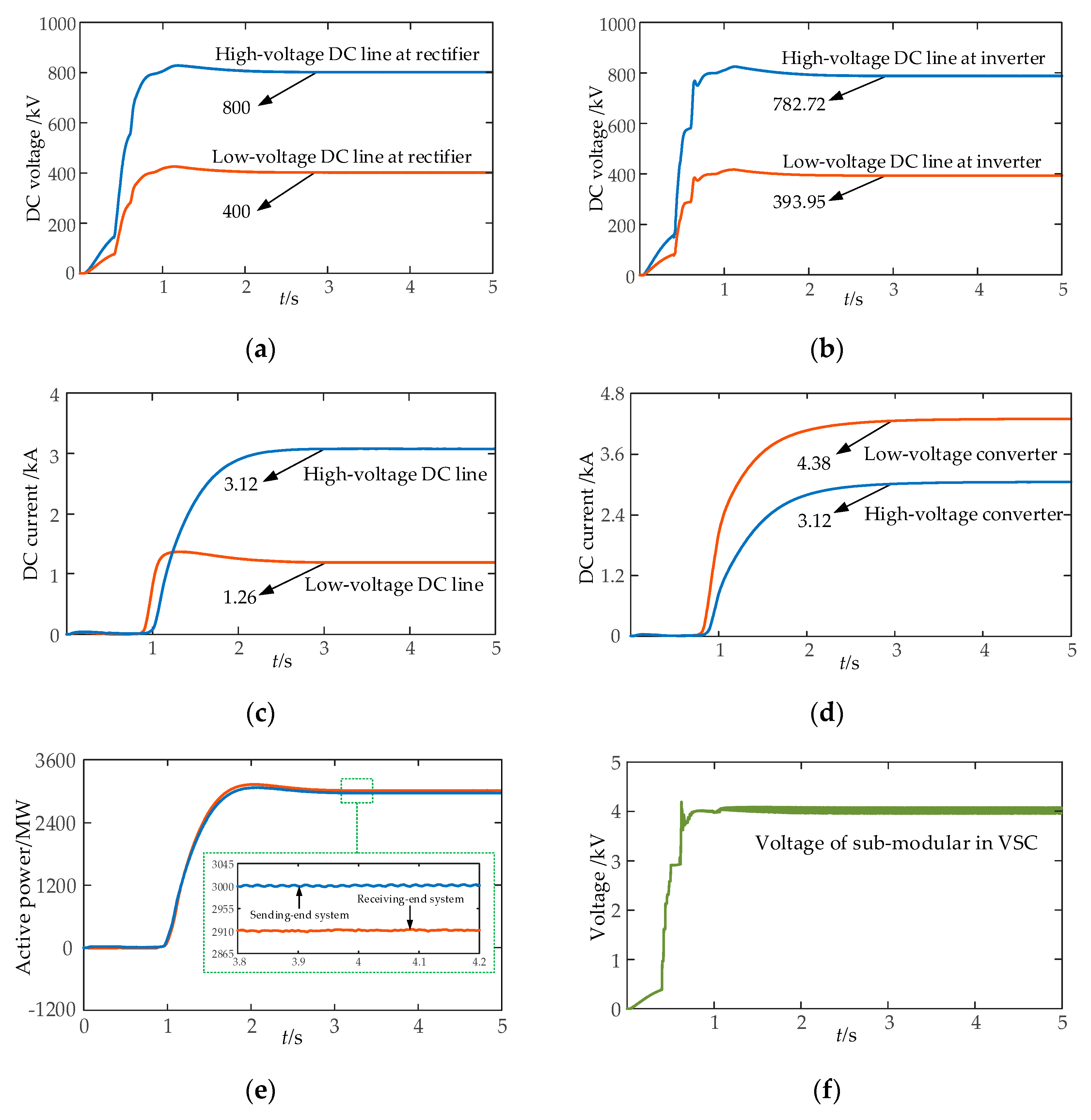
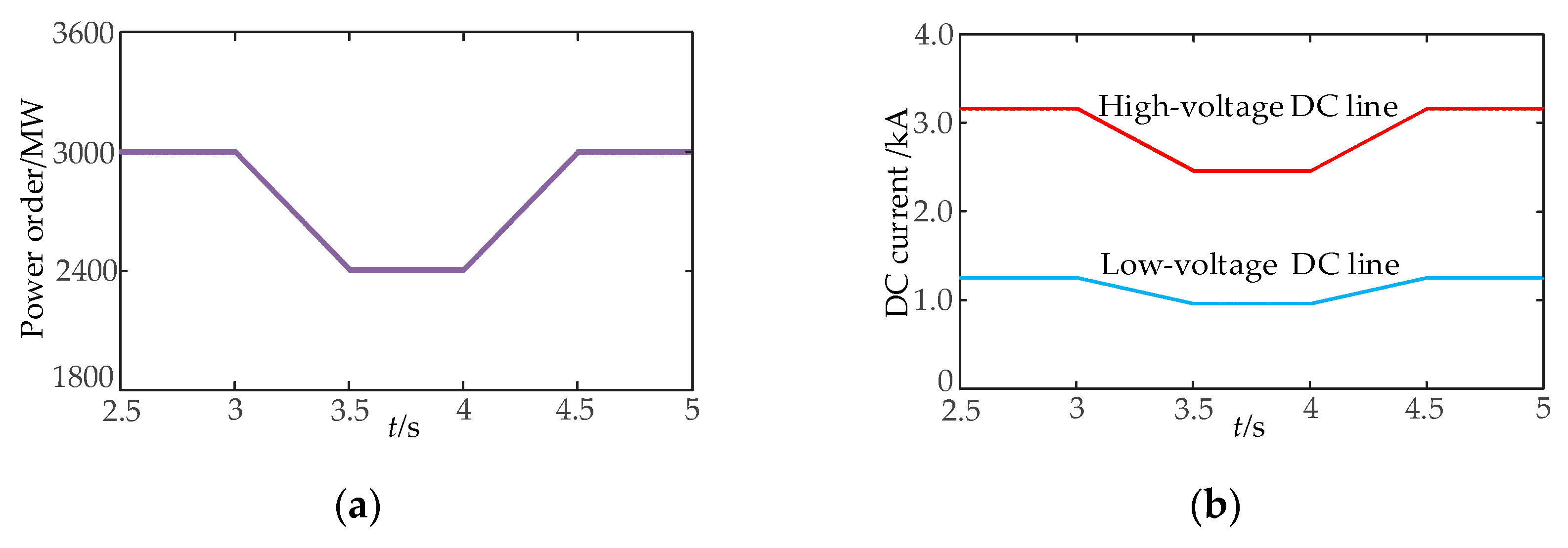


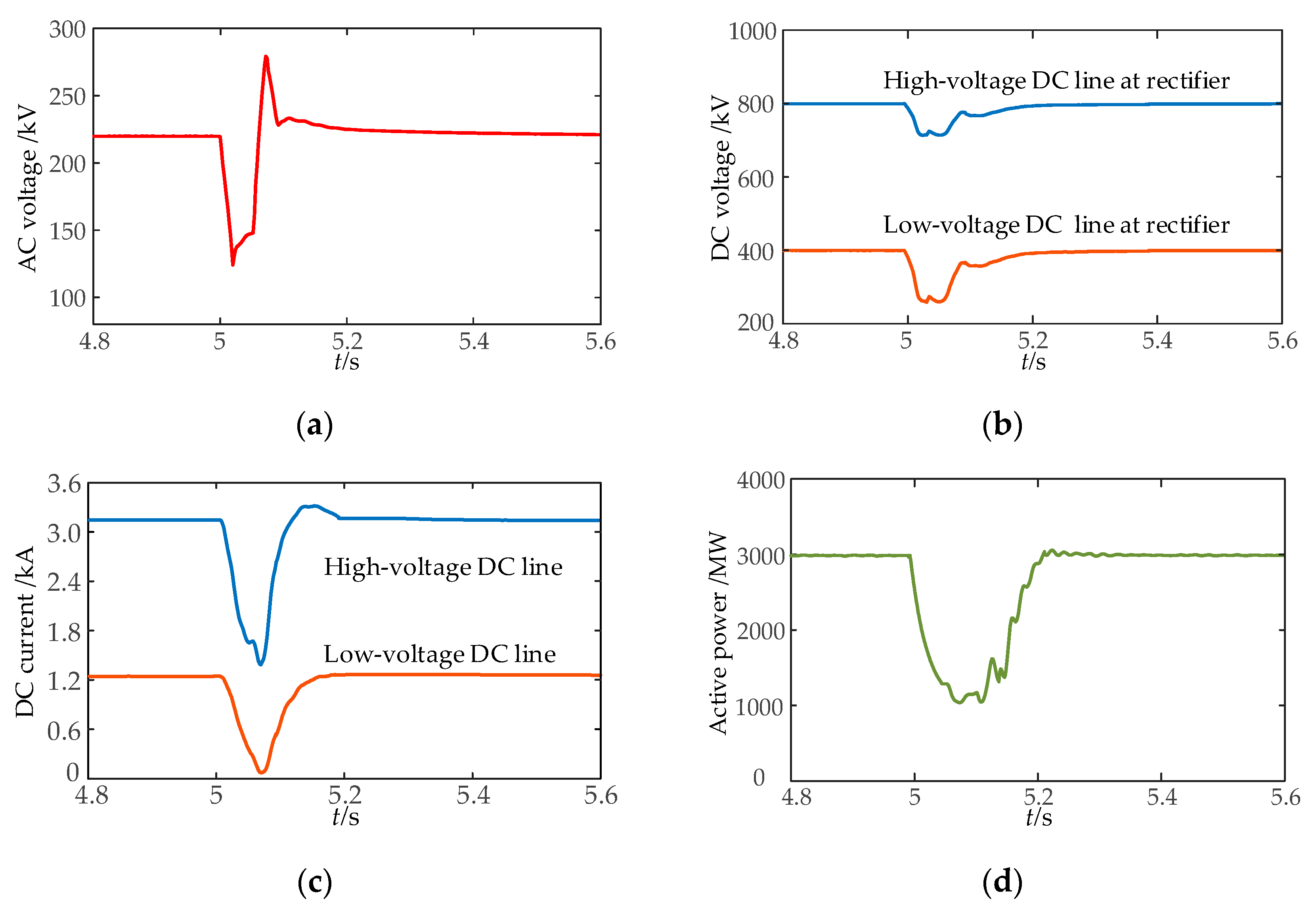
| Number | Id1(kA) | Id2(kA) | PLoss(MW) | U1’ (kV) | U2’ (kV) |
|---|---|---|---|---|---|
| 1 | 5.450 | 2.050 | 112.38 | 383.68 | 776.30 |
| 2 | 5.400 | 2.100 | 109.84 | 384.16 | 776.60 |
| 3 | 5.300 | 2.200 | 105.16 | 385.12 | 777.20 |
| 4 | 5.200 | 2.300 | 101.01 | 386.08 | 777.80 |
| 5 | 5.100 | 2.400 | 97.39 | 387.04 | 778.40 |
| 6 | 5.000 | 2.500 | 94.30 | 388.00 | 779.00 |
| 7 | 4.900 | 2.600 | 91.75 | 388.96 | 779.60 |
| 8 | 4.800 | 2.700 | 89.73 | 389.92 | 780.20 |
| 9 | 4.700 | 2.800 | 88.24 | 390.88 | 780.80 |
| 10 | 4.600 | 2.900 | 87.28 | 391.84 | 781.40 |
| 11 | 4.500 | 3.000 | 86.87 | 392.80 | 782.00 |
| 12 | 4.400 | 3.100 | 86.98 | 393.76 | 782.60 |
| 13 | 4.380 | 3.120 | 87.07 | 393.95 | 782.72 |
| 14 | 4.375 | 3.125 | 87.10 | 394.00 | 782.75 |
| 15 | 4.300 | 3.200 | 87.63 | 394.72 | 783.20 |
| Parameters | Rectifier | Inverter |
|---|---|---|
| AC voltage/kV | 380 | 220 |
| Rated capacity/MW | 3000 | 3000 |
| DC voltage/kV | 800 | 782.72 |
| Converter type | LCC | MMC |
| Number of sub-modules | / | 100 |
| Transformer ratio | 380/172 | 161/220 |
Publisher’s Note: MDPI stays neutral with regard to jurisdictional claims in published maps and institutional affiliations. |
© 2022 by the authors. Licensee MDPI, Basel, Switzerland. This article is an open access article distributed under the terms and conditions of the Creative Commons Attribution (CC BY) license (https://creativecommons.org/licenses/by/4.0/).
Share and Cite
Yang, Z.; Gao, B.; Cao, Z. Optimal Current Allocation Strategy for Hybrid Hierarchical HVDC System with Parallel Operation of High-Voltage and Low-Voltage DC Lines. Processes 2022, 10, 579. https://doi.org/10.3390/pr10030579
Yang Z, Gao B, Cao Z. Optimal Current Allocation Strategy for Hybrid Hierarchical HVDC System with Parallel Operation of High-Voltage and Low-Voltage DC Lines. Processes. 2022; 10(3):579. https://doi.org/10.3390/pr10030579
Chicago/Turabian StyleYang, Zhichao, Bingtuan Gao, and Zeyu Cao. 2022. "Optimal Current Allocation Strategy for Hybrid Hierarchical HVDC System with Parallel Operation of High-Voltage and Low-Voltage DC Lines" Processes 10, no. 3: 579. https://doi.org/10.3390/pr10030579
APA StyleYang, Z., Gao, B., & Cao, Z. (2022). Optimal Current Allocation Strategy for Hybrid Hierarchical HVDC System with Parallel Operation of High-Voltage and Low-Voltage DC Lines. Processes, 10(3), 579. https://doi.org/10.3390/pr10030579






